- Home
- Mark Twain
What Is Man? and Other Essays Page 11
What Is Man? and Other Essays Read online
Page 11
And so I do not admire the human being—as an intellectual marvel—as much as I did when I was young, and got him out of books, and did not know him personally. When I used to read that such and such a general did a certain brilliant thing, I believed it. Whereas it was not so. Circumstance did it by help of his temperament. The circumstances would have failed of effect with a general of another temperament: he might see the chance, but lose the advantage by being by nature too slow or too quick or too doubtful. Once General Grant was asked a question about a matter which had been much debated by the public and the newspapers; he answered the question without any hesitancy. "General, who planned the the march through Georgia?" "The enemy!" He added that the enemy usually makes your plans for you. He meant that the enemy by neglect or through force of circumstances leaves an opening for you, and you see your chance and take advantage of it.
Circumstances do the planning for us all, no doubt, by help of our temperaments. I see no great difference between a man and a watch, except that the man is conscious and the watch isn't, and the man TRIES to plan things and the watch doesn't. The watch doesn't wind itself and doesn't regulate itself—these things are done exteriorly. Outside influences, outside circumstances, wind the MAN and regulate him. Left to himself, he wouldn't get regulated at all, and the sort of time he would keep would not be valuable. Some rare men are wonderful watches, with gold case, compensation balance, and all those things, and some men are only simple and sweet and humble Waterburys. I am a Waterbury. A Waterbury of that kind, some say.
A nation is only an individual multiplied. It makes plans and Circumstances comes and upsets them—or enlarges them. Some patriots throw the tea overboard; some other patriots destroy a Bastille. The PLANS stop there; then Circumstance comes in, quite unexpectedly, and turns these modest riots into a revolution.
And there was poor Columbus. He elaborated a deep plan to find a new route to an old country. Circumstance revised his plan for him, and he found a new WORLD. And HE gets the credit of it to this day. He hadn't anything to do with it.
Necessarily the scene of the real turning-point of my life (and of yours) was the Garden of Eden. It was there that the first link was forged of the chain that was ultimately to lead to the emptying of me into the literary guild. Adam's TEMPERAMENT was the first command the Deity ever issued to a human being on this planet. And it was the only command Adam would NEVER be able to disobey. It said, "Be weak, be water, be characterless, be cheaply persuadable." The latter command, to let the fruit alone, was certain to be disobeyed. Not by Adam himself, but by his TEMPERAMENT—which he did not create and had no authority over. For the TEMPERAMENT is the man; the thing tricked out with clothes and named Man is merely its Shadow, nothing more. The law of the tiger's temperament is, Thou shalt kill; the law of the sheep's temperament is Thou shalt not kill. To issue later commands requiring the tiger to let the fat stranger alone, and requiring the sheep to imbue its hands in the blood of the lion is not worth while, for those commands CAN'T be obeyed. They would invite to violations of the law of TEMPERAMENT, which is supreme, and take precedence of all other authorities. I cannot help feeling disappointed in Adam and Eve. That is, in their temperaments. Not in THEM, poor helpless young creatures— afflicted with temperaments made out of butter; which butter was commanded to get into contact with fire and BE MELTED. What I cannot help wishing is, that Adam had been postponed, and Martin Luther and Joan of Arc put in their place—that splendid pair equipped with temperaments not made of butter, but of asbestos. By neither sugary persuasions nor by hell fire could Satan have beguiled THEM to eat the apple. There would have been results! Indeed, yes. The apple would be intact today; there would be no human race; there would be no YOU; there would be no ME. And the old, old creation-dawn scheme of ultimately launching me into the literary guild would have been defeated.
How to Make History Dates Stick
These chapters are for children, and I shall try to make the words large enough to command respect. In the hope that you are listening, and that you have confidence in me, I will proceed. Dates are difficult things to acquire; and after they are acquired it is difficult to keep them in the head. But they are very valuable. They are like the cattle-pens of a ranch—they shut in the several brands of historical cattle, each within its own fence, and keep them from getting mixed together. Dates are hard to remember because they consist of figures; figures are monotonously unstriking in appearance, and they don't take hold, they form no pictures, and so they give the eye no chance to help. Pictures are the thing. Pictures can make dates stick. They can make nearly anything stick—particularly IF YOU MAKE THE PICTURES YOURSELF. Indeed, that is the great point—make the pictures YOURSELF. I know about this from experience. Thirty years ago I was delivering a memorized lecture every night, and every night I had to help myself with a page of notes to keep from getting myself mixed. The notes consisted of beginnings of sentences, and were eleven in number, and they ran something like this:
"IN THAT REGION THE WEATHER—"
"AT THAT TIME IT WAS A CUSTOM—"
"BUT IN CALIFORNIA ONE NEVER HEARD—"
Eleven of them. They initialed the brief divisions of the lecture and protected me against skipping. But they all looked about alike on the page; they formed no picture; I had them by heart, but I could never with certainty remember the order of their succession; therefore I always had to keep those notes by me and look at them every little while. Once I mislaid them; you will not be able to imagine the terrors of that evening. I now saw that I must invent some other protection. So I got ten of the initial letters by heart in their proper order—I, A, B, and so on—and I went on the platform the next night with these marked in ink on my ten finger-nails. But it didn't answer. I kept track of the figures for a while; then I lost it, and after that I was never quite sure which finger I had used last. I couldn't lick off a letter after using it, for while that would have made success certain it also would have provoked too much curiosity. There was curiosity enough without that. To the audience I seemed more interested in my fingernails than I was in my subject; one or two persons asked me afterward what was the matter with my hands.
It was now that the idea of pictures occurred to me; then my troubles passed away. In two minutes I made six pictures with a pen, and they did the work of the eleven catch-sentences, and did it perfectly. I threw the pictures away as soon as they were made, for I was sure I could shut my eyes and see them any time. That was a quarter of a century ago; the lecture vanished out of my head more than twenty years ago, but I would rewrite it from the pictures—for they remain. Here are three of them: (Fig. 1).
The first one is a haystack—below it a rattlesnake—and it told me where to begin to talk ranch-life in Carson Valley. The second one told me where to begin the talk about a strange and violent wind that used to burst upon Carson City from the Sierra Nevadas every afternoon at two o'clock and try to blow the town away. The third picture, as you easily perceive, is lightning; its duty was to remind me when it was time to begin to talk about San Francisco weather, where there IS no lightning—nor thunder, either—and it never failed me.
I will give you a valuable hint. When a man is making a speech and you are to follow him don't jot down notes to speak from, jot down PICTURES. It is awkward and embarrassing to have to keep referring to notes; and besides it breaks up your speech and makes it ragged and non-coherent; but you can tear up your pictures as soon as you have made them—they will stay fresh and strong in your memory in the order and sequence in which you scratched them down. And many will admire to see what a good memory you are furnished with, when perhaps your memory is not any better than mine.
Sixteen years ago when my children were little creatures the governess was trying to hammer some primer histories into their heads. Part of this fun—if you like to call it that—consisted in the memorizing of the accession dates of the thirty-seven personages who had ruled England from the Conqueror down. These little people found it a b
itter, hard contract. It was all dates, and all looked alike, and they wouldn't stick. Day after day of the summer vacation dribbled by, and still the kings held the fort; the children couldn't conquer any six of them.
With my lecture experience in mind I was aware that I could invent some way out of the trouble with pictures, but I hoped a way could be found which would let them romp in the open air while they learned the kings. I found it, and they mastered all the monarchs in a day or two.
The idea was to make them SEE the reigns with their eyes; that would be a large help. We were at the farm then. From the house-porch the grounds sloped gradually down to the lower fence and rose on the right to the high ground where my small work-den stood. A carriage-road wound through the grounds and up the hill. I staked it out with the English monarchs, beginning with the Conqueror, and you could stand on the porch and clearly see every reign and its length, from the Conquest down to Victoria, then in the forty-sixth year of her reign—EIGHT HUNDRED AND SEVENTEEN YEARS OF English history under your eye at once!
English history was an unusually live topic in America just then. The world had suddenly realized that while it was not noticing the Queen had passed Henry VIII., passed Henry VI. and Elizabeth, and gaining in length every day. Her reign had entered the list of the long ones; everybody was interested now— it was watching a race. Would she pass the long Edward? There was a possibility of it. Would she pass the long Henry? Doubtful, most people said. The long George? Impossible! Everybody said it. But we have lived to see her leave him two years behind.
I measured off 817 feet of the roadway, a foot representing a year, and at the beginning and end of each reign I drove a three-foot white-pine stake in the turf by the roadside and wrote the name and dates on it. Abreast the middle of the porch-front stood a great granite flower-vase overflowing with a cataract of bright-yellow flowers—I can't think of their name. The vase of William the Conqueror. We put his name on it and his accession date, 1066. We started from that and measured off twenty-one feet of the road, and drove William Rufus's state; then thirteen feet and drove the first Henry's stake; then thirty-five feet and drove Stephen's; then nineteen feet, which brought us just past the summer-house on the left; then we staked out thirty-five, ten, and seventeen for the second Henry and Richard and John; turned the curve and entered upon just what was needed for Henry III.—a level, straight stretch of fifty-six feet of road without a crinkle in it. And it lay exactly in front of the house, in the middle of the grounds. There couldn't have been a better place for that long reign; you could stand on the porch and see those two wide-apart stakes almost with your eyes shut. (Fig. 2.)
That isn't the shape of the road—I have bunched it up like that to save room. The road had some great curves in it, but their gradual sweep was such that they were no mar to history. No, in our road one could tell at a glance who was who by the size of the vacancy between stakes—with LOCALITY to help, of course.
Although I am away off here in a Swedish village[4] and those stakes did not stand till the snow came, I can see them today as plainly as ever; and whenever I think of an English monarch his stakes rise before me of their own accord and I notice the large or small space which he takes up on our road. Are your kings spaced off in your mind? When you think of Richard III. and of James II. do the durations of their reigns seem about alike to you? It isn't so to me; I always notice that there's a foot's difference. When you think of Henry III. do you see a great long stretch of straight road? I do; and just at the end where it joins on to Edward I. I always see a small pear-bush with its green fruit hanging down. When I think of the Commonwealth I see a shady little group of these small saplings which we called the oak parlor; when I think of George III. I see him stretching up the hill, part of him occupied by a flight of stone steps; and I can locate Stephen to an inch when he comes into my mind, for he just filled the stretch which went by the summer-house. Victoria's reign reached almost to my study door on the first little summit; there's sixteen feet to be added now; I believe that that would carry it to a big pine-tree that was shattered by some lightning one summer when it was trying to hit me.
We got a good deal of fun out of the history road; and exercise, too. We trotted the course from the conqueror to the study, the children calling out the names, dates, and length of reigns as we passed the stakes, going a good gait along the long reigns, but slowing down when we came upon people like Mary and Edward VI., and the short Stuart and Plantagenet, to give time to get in the statistics. I offered prizes, too—apples. I threw one as far as I could send it, and the child that first shouted the reign it fell in got the apple.
The children were encouraged to stop locating things as being "over by the arbor," or "in the oak parlor," or "up at the stone steps," and say instead that the things were in Stephen, or in the Commonwealth, or in George III. They got the habit without trouble. To have the long road mapped out with such exactness was a great boon for me, for I had the habit of leaving books and other articles lying around everywhere, and had not previously been able to definitely name the place, and so had often been obliged to go to fetch them myself, to save time and failure; but now I could name the reign I left them in, and send the children.
Next I thought I would measure off the French reigns, and peg them alongside the English ones, so that we could always have contemporaneous French history under our eyes as we went our English rounds. We pegged them down to the Hundred Years' War, then threw the idea aside, I do not now remember why. After that we made the English pegs fence in European and American history as well as English, and that answered very well. English and alien poets, statesmen, artists, heroes, battles, plagues, cataclysms, revolutions—we shoveled them all into the English fences according to their dates. Do you understand? We gave Washington's birth to George II.'s pegs and his death to George III.'s; George II. got the Lisbon earthquake and George III. the Declaration of Independence. Goethe, Shakespeare, Napoleon, Savonarola, Joan of Arc, the French Revolution, the Edict of Nantes, Clive, Wellington, Waterloo, Plassey, Patay, Cowpens, Saratoga, the Battle of the Boyne, the invention of the logarithms, the microscope, the steam-engine, the telegraph— anything and everything all over the world—we dumped it all in among the English pegs according to it date and regardless of its nationality.
If the road-pegging scheme had not succeeded I should have lodged the kings in the children's heads by means of pictures— that is, I should have tried. It might have failed, for the pictures could only be effective WHEN MADE BY THE PUPIL; not the master, for it is the work put upon the drawing that makes the drawing stay in the memory, and my children were too little to make drawings at that time. And, besides, they had no talent for art, which is strange, for in other ways they are like me.
But I will develop the picture plan now, hoping that you will be able to use it. It will come good for indoors when the weather is bad and one cannot go outside and peg a road. Let us imagine that the kings are a procession, and that they have come out of the Ark and down Ararat for exercise and are now starting back again up the zigzag road. This will bring several of them into view at once, and each zigzag will represent the length of a king's reign.
And so on. You will have plenty of space, for by my project you will use the parlor wall. You do not mark on the wall; that would cause trouble. You only attach bits of paper to it with pins or thumb-tacks. These will leave no mark.
Take your pen now, and twenty-one pieces of white paper, each two inches square, and we will do the twenty-one years of the Conqueror's reign. On each square draw a picture of a whale and write the dates and term of service. We choose the whale for several reasons: its name and William's begin with the same letter; it is the biggest fish that swims, and William is the most conspicuous figure in English history in the way of a landmark; finally, a whale is about the easiest thing to draw. By the time you have drawn twenty-one wales and written "William I.—1066-1087—twenty-one years" twenty-one times, those details will be your property; you cannot di
slodge them from your memory with anything but dynamite. I will make a sample for you to copy: (Fig. 3).
I have got his chin up too high, but that is no matter; he is looking for Harold. It may be that a whale hasn't that fin up there on his back, but I do not remember; and so, since there is a doubt, it is best to err on the safe side. He looks better, anyway, than he would without it.
Be very careful and ATTENTIVE while you are drawing your first whale from my sample and writing the word and figures under it, so that you will not need to copy the sample any more. Compare your copy with the sample; examine closely; if you find you have got everything right and can shut your eyes and see the picture and call the words and figures, then turn the sample and copy upside down and make the next copy from memory; and also the next and next, and so on, always drawing and writing from memory until you have finished the whole twenty-one. This will take you twenty minutes, or thirty, and by that time you will find that you can make a whale in less time than an unpracticed person can make a sardine; also, up to the time you die you will always be able to furnish William's dates to any ignorant person that inquires after them.
You will now take thirteen pieces of BLUE paper, each two inches square, and do William II. (Fig. 4.)
Make him spout his water forward instead of backward; also make him small, and stick a harpoon in him and give him that sick look in the eye. Otherwise you might seem to be continuing the other William, and that would be confusing and a damage. It is quite right to make him small; he was only about a No. 11 whale, or along there somewhere; there wasn't room in him for his father's great spirit. The barb of that harpoon ought not to show like that, because it is down inside the whale and ought to be out of sight, but it cannot be helped; if the barb were removed people would think some one had stuck a whip-stock into the whale. It is best to leave the barb the way it is, then every one will know it is a harpoon and attending to business. Remember—draw from the copy only once; make your other twelve and the inscription from memory.

 A Connecticut Yankee in King Arthur's Court
A Connecticut Yankee in King Arthur's Court Adventures of Huckleberry Finn
Adventures of Huckleberry Finn The Adventures of Tom Sawyer, Part 1.
The Adventures of Tom Sawyer, Part 1. The Prince and the Pauper
The Prince and the Pauper The American Claimant
The American Claimant Eve's Diary, Complete
Eve's Diary, Complete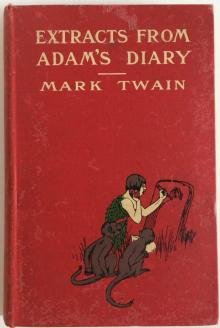 Extracts from Adam's Diary, translated from the original ms.
Extracts from Adam's Diary, translated from the original ms. A Tramp Abroad
A Tramp Abroad The Best Short Works of Mark Twain
The Best Short Works of Mark Twain Humorous Hits and How to Hold an Audience
Humorous Hits and How to Hold an Audience The Speculative Fiction of Mark Twain
The Speculative Fiction of Mark Twain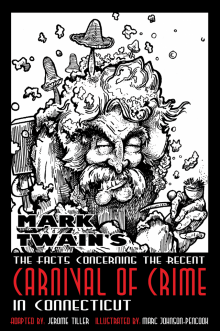 The Facts Concerning the Recent Carnival of Crime in Connecticut
The Facts Concerning the Recent Carnival of Crime in Connecticut Alonzo Fitz, and Other Stories
Alonzo Fitz, and Other Stories The $30,000 Bequest, and Other Stories
The $30,000 Bequest, and Other Stories Pudd'nhead Wilson and Those Extraordinary Twins
Pudd'nhead Wilson and Those Extraordinary Twins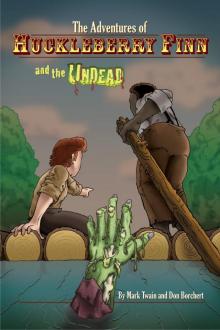 The Adventures of Huckleberry Finn and the Undead
The Adventures of Huckleberry Finn and the Undead Sketches New and Old
Sketches New and Old The Man That Corrupted Hadleyburg
The Man That Corrupted Hadleyburg A Tramp Abroad — Volume 06
A Tramp Abroad — Volume 06 A Tramp Abroad — Volume 02
A Tramp Abroad — Volume 02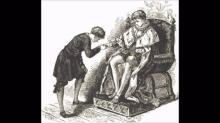 The Prince and the Pauper, Part 1.
The Prince and the Pauper, Part 1. Adventures of Huckleberry Finn, Chapters 16 to 20
Adventures of Huckleberry Finn, Chapters 16 to 20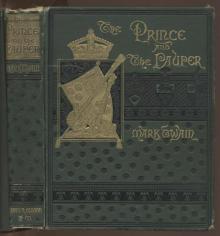 The Prince and the Pauper, Part 9.
The Prince and the Pauper, Part 9. Adventures of Huckleberry Finn, Chapters 21 to 25
Adventures of Huckleberry Finn, Chapters 21 to 25 Tom Sawyer, Detective
Tom Sawyer, Detective A Tramp Abroad (Penguin ed.)
A Tramp Abroad (Penguin ed.) Adventures of Huckleberry Finn, Chapters 36 to the Last
Adventures of Huckleberry Finn, Chapters 36 to the Last The Mysterious Stranger, and Other Stories
The Mysterious Stranger, and Other Stories A Tramp Abroad — Volume 03
A Tramp Abroad — Volume 03 The Adventures of Tom Sawyer, Part 3.
The Adventures of Tom Sawyer, Part 3. Adventures of Huckleberry Finn, Chapters 06 to 10
Adventures of Huckleberry Finn, Chapters 06 to 10_preview.jpg) The Adventures of Huckleberry Finn (Tom Sawyer's Comrade)
The Adventures of Huckleberry Finn (Tom Sawyer's Comrade)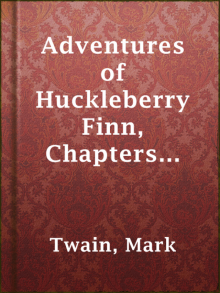 Adventures of Huckleberry Finn, Chapters 31 to 35
Adventures of Huckleberry Finn, Chapters 31 to 35 The Man That Corrupted Hadleyburg, and Other Stories
The Man That Corrupted Hadleyburg, and Other Stories A Tramp Abroad — Volume 07
A Tramp Abroad — Volume 07 Editorial Wild Oats
Editorial Wild Oats Adventures of Huckleberry Finn, Chapters 26 to 30
Adventures of Huckleberry Finn, Chapters 26 to 30 1601: Conversation as it was by the Social Fireside in the Time of the Tudors
1601: Conversation as it was by the Social Fireside in the Time of the Tudors A Tramp Abroad — Volume 05
A Tramp Abroad — Volume 05 Sketches New and Old, Part 1.
Sketches New and Old, Part 1. The Adventures of Tom Sawyer, Part 2.
The Adventures of Tom Sawyer, Part 2. A Connecticut Yankee in King Arthur's Court, Part 8.
A Connecticut Yankee in King Arthur's Court, Part 8. A Tramp Abroad — Volume 01
A Tramp Abroad — Volume 01 The Adventures of Tom Sawyer, Part 5.
The Adventures of Tom Sawyer, Part 5. Adventures of Huckleberry Finn, Chapters 01 to 05
Adventures of Huckleberry Finn, Chapters 01 to 05 A Connecticut Yankee in King Arthur's Court, Part 1.
A Connecticut Yankee in King Arthur's Court, Part 1.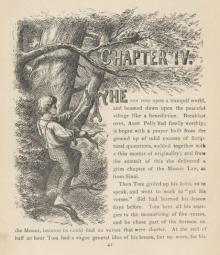 The Adventures of Tom Sawyer, Part 4.
The Adventures of Tom Sawyer, Part 4. A Connecticut Yankee in King Arthur's Court, Part 2.
A Connecticut Yankee in King Arthur's Court, Part 2. The Adventures of Tom Sawyer, Part 7.
The Adventures of Tom Sawyer, Part 7.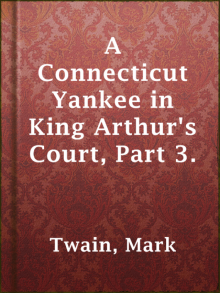 A Connecticut Yankee in King Arthur's Court, Part 3.
A Connecticut Yankee in King Arthur's Court, Part 3. Sketches New and Old, Part 4.
Sketches New and Old, Part 4. Sketches New and Old, Part 3.
Sketches New and Old, Part 3. A Connecticut Yankee in King Arthur's Court, Part 7.
A Connecticut Yankee in King Arthur's Court, Part 7. A Connecticut Yankee in King Arthur's Court, Part 5.
A Connecticut Yankee in King Arthur's Court, Part 5. A Connecticut Yankee in King Arthur's Court, Part 6.
A Connecticut Yankee in King Arthur's Court, Part 6. A Connecticut Yankee in King Arthur's Court, Part 4.
A Connecticut Yankee in King Arthur's Court, Part 4. Sketches New and Old, Part 2.
Sketches New and Old, Part 2. Sketches New and Old, Part 6.
Sketches New and Old, Part 6. Adventures of Huckleberry Finn, Chapters 11 to 15
Adventures of Huckleberry Finn, Chapters 11 to 15 Personal Recollections of Joan of Arc
Personal Recollections of Joan of Arc Sketches New and Old, Part 5.
Sketches New and Old, Part 5. Eve's Diary, Part 3
Eve's Diary, Part 3 Sketches New and Old, Part 7.
Sketches New and Old, Part 7. Mark Twain on Religion: What Is Man, the War Prayer, Thou Shalt Not Kill, the Fly, Letters From the Earth
Mark Twain on Religion: What Is Man, the War Prayer, Thou Shalt Not Kill, the Fly, Letters From the Earth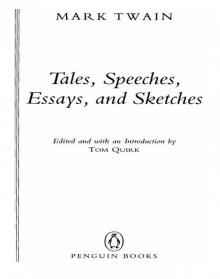 Tales, Speeches, Essays, and Sketches
Tales, Speeches, Essays, and Sketches A Connecticut Yankee in King Arthur's Court, Part 9.
A Connecticut Yankee in King Arthur's Court, Part 9. Our Fellow Savages of the Sandwich Islands (version 1)
Our Fellow Savages of the Sandwich Islands (version 1) 1601
1601 Letters from the Earth
Letters from the Earth Curious Republic Of Gondour, And Other Curious Whimsical Sketches
Curious Republic Of Gondour, And Other Curious Whimsical Sketches The Mysterious Stranger
The Mysterious Stranger Life on the Mississippi
Life on the Mississippi Roughing It
Roughing It Alonzo Fitz and Other Stories
Alonzo Fitz and Other Stories The 30,000 Dollar Bequest and Other Stories
The 30,000 Dollar Bequest and Other Stories The Adventures of Huckleberry Finn taots-2
The Adventures of Huckleberry Finn taots-2 A Double-Barreled Detective Story
A Double-Barreled Detective Story adam's diary.txt
adam's diary.txt A Horse's Tale
A Horse's Tale Autobiography Of Mark Twain, Volume 1
Autobiography Of Mark Twain, Volume 1 The Comedy of Those Extraordinary Twins
The Comedy of Those Extraordinary Twins Following the Equator
Following the Equator Goldsmith's Friend Abroad Again
Goldsmith's Friend Abroad Again No. 44, The Mysterious Stranger
No. 44, The Mysterious Stranger The Stolen White Elephant
The Stolen White Elephant The $30,000 Bequest and Other Stories
The $30,000 Bequest and Other Stories The Curious Republic of Gondour, and Other Whimsical Sketches
The Curious Republic of Gondour, and Other Whimsical Sketches Prince and the Pauper (Barnes & Noble Classics Series)
Prince and the Pauper (Barnes & Noble Classics Series) The Portable Mark Twain
The Portable Mark Twain Connecticut Yankee in King Arthur's Court (Barnes & Noble Classics Series)
Connecticut Yankee in King Arthur's Court (Barnes & Noble Classics Series)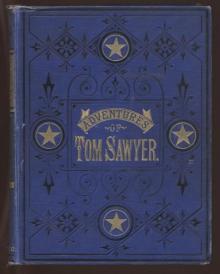 The Adventures of Tom Sawyer taots-1
The Adventures of Tom Sawyer taots-1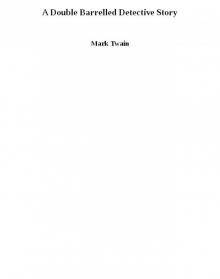 A Double Barrelled Detective Story
A Double Barrelled Detective Story Eve's Diary
Eve's Diary A Dog's Tale
A Dog's Tale The Mysterious Stranger Manuscripts (Literature)
The Mysterious Stranger Manuscripts (Literature) The Complete Short Stories of Mark Twain
The Complete Short Stories of Mark Twain What Is Man? and Other Essays
What Is Man? and Other Essays The Adventures of Huckleberry Finn
The Adventures of Huckleberry Finn Adventures of Huckleberry Finn and Zombie Jim
Adventures of Huckleberry Finn and Zombie Jim Who Is Mark Twain?
Who Is Mark Twain? Christian Science
Christian Science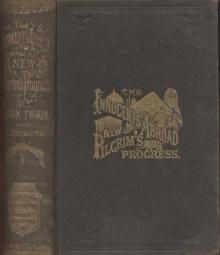 The Innocents Abroad
The Innocents Abroad Some Rambling Notes of an Idle Excursion
Some Rambling Notes of an Idle Excursion Autobiography of Mark Twain
Autobiography of Mark Twain Those Extraordinary Twins
Those Extraordinary Twins Autobiography of Mark Twain: The Complete and Authoritative Edition, Volume 1
Autobiography of Mark Twain: The Complete and Authoritative Edition, Volume 1